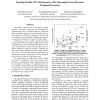Free Online Productivity Tools
i2Speak
i2Symbol
i2OCR
iTex2Img
iWeb2Print
iWeb2Shot
i2Type
iPdf2Split
iPdf2Merge
i2Bopomofo
i2Arabic
i2Style
i2Image
i2PDF
iLatex2Rtf
Sci2ools
ISCA
2012
IEEE
2012
IEEE
Boosting mobile GPU performance with a decoupled access/execute fragment processor
Smartphones represent one of the fastest growing markets, providing significant hardware/software improvements every few months. However, supporting these capabilities reduces the operating time per battery charge. The CPU/GPU component is only left with a shrinking fraction of the power budget, since most of the energy is consumed by the screen and the antenna. In this paper, we focus on improving the energy efficiency of the GPU since graphical applications consist an important part of the existing market. Moreover, the trend towards better screens will inevitably lead to a higher demand for improved graphics rendering. We show that the main bottleneck for these applications is the texture cache and that traditional techniques for hiding memory latency (prefetching, multithreading) do not work well or come at a high energy cost. We thus propose the migration of GPU designs towards the decoupled access-execute concept. Furthermore, we significantly reduce bandwidth usage in the decou...
| Added | 28 Sep 2012 |
| Updated | 28 Sep 2012 |
| Type | Journal |
| Year | 2012 |
| Where | ISCA |
| Authors | Jose-Maria Arnau, Joan-Manuel Parcerisa, Polychronis Xekalakis |
Comments (0)

